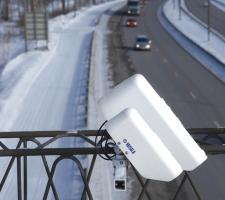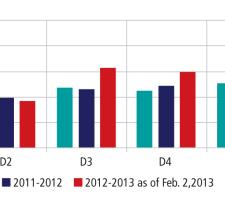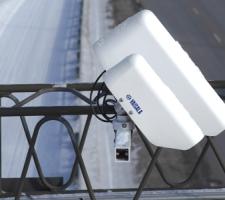
Figure 1
Idaho’s use of key performance indicators to determine the effectiveness of its winter maintenance programme put it on the Best of
In common with many other authorities, ITD had found it difficult to assess how well its winter maintenance budget was being spent and the effect it had on the road network in terms of mobility and safety. To overcome this, and to provide a measure of effectiveness for the winter maintenance program, ITD has implemented a system of key performance indicators (KPIs).
The basis of the system is ITD’s network of 100 road weather information sensors (RWIS). These are polled every 15 minutes for atmospheric and road conditions including road surface temperature, surface condition (dry, wet, snow or ice), the thickness of any water, snow, ice or frost layer and the grip (friction coefficient). This data is used to track changes to air and road temperatures, surface friction and trends of ice/snow build-up or removal (through ploughing or melting). ITD’s maintenance teams use this data to prioritise which roads to treat and decide the appropriate treatment and application rate.
When the RWIS system was first introduced it met a mixed reaction from staff as to how the data should be used and applied. Subsequently there has been a gradual acceptance and increased use of the data within the decision making process. In particular, two early adopters detected patterns in the data that could be directly linked with winter maintenance operations.
In particular the grip parameter showed a good correlation between the severity of a storm and the impact on vehicle mobility.
Grip level is shown as a number between 0 and 1 with higher numbers indicating better grip; so 0.82 indicates an exposed road surface whereas 0.1 would indicate very slippery conditions, probably due to snow or ice. In Idaho, the users made the following observations:
• 0.6 and above - wet or dry surface with normal mobility
• 0.5 to 0.6 - slush or ice forming causing slight mobility reduction
• 0.4 to 0.5 - pack snow or ice causing moderate mobility reduction
• 0.3 to 0.4 - icy conditions vehicles may start sliding off the road
• 0.3 and below - icy conditions with multiple vehicle slide offs possible; mobility greatly affected.
Grip is evaluated by
The
Between 2010 and 2012, ITD’s staff developed and refined these relationships to produce two winter key maintenance performance measures: the Storm Severity Index and the Winter Performance Index.
The Storm Severity Index is calculated using the maximum wind speed (WS) in miles per hour, the maximum water equivalent layer (WEL) in mm, and the minimum surface temperature (ST) in °F. The formula is shown below:
Storm Severity Index = WS + WEL + 300/ST
This gives an index that ranges from 10 to 80 for typical storms while severe cold and high winds will see it running as high as 500. Meteorologist Paul Bridge from Vaisala told
For ITD staff to calculate the Winter Performance Index, the Ice-Up Time has first to be determined and represents the duration in hours (minimum 0.5 hour) when the grip is below 0.6. The Ice-Up Time is then divided by the Storm Severity Index to give the Winter Performance Index (WPI). This figure ranges from 0.00 to 0.7 where 0.00 represents road surfaces that are below freezing but still offer good grip while 0.7 indicates the potential for multiple slide-offs. The aim is to keep the WPI at or below 0.5.
Finally, the Winter Mobility Index is calculated as the key performance indicator for each storm. The index ranges from 0 – 1 and represents the percentage of time the road conditions did not significantly impede mobility during a winter storm. Mobility is deemed to have been impaired if the grip value falls lower than 0.6 and with precipitation lying on a below-freezing road surface.
Initially these calculations were made manually with detailed analysis of each set of RWIS surface and atmospheric data for every winter storm. So ITD partnered with Vaisala to automate the process by integrating the model and algorithms directly into Navigator II, Vaisala’s RWIS visualisation application program. Maintenance managers can now view the results of their maintenance performance almost immediately after each winter storm has passed.
Results from the Storm Severity Index, Winter Performance Measure and the Winter Mobility Index calculations can be seen in Figure 1.
The goals of the winter performance measures are tied to ITD’s strategic plan. They track progress towards maintaining safe roads and mobility and promote cost-effective winter road maintenance within the available resources. They also aim to improve uniformity in winter operations across the state and maximise economic opportunity by minimising weather impacts on commerce.
Each of the six ITD Districts has its own winter maintenance challenges according to local topography, highway usage and weather patterns, the maintenance resources available and the maintenance priorities. As such the results should be viewed in relative terms rather than comparing one area to another. The focus is to build tools for managing winter performance improvements for each district, starting with baseline data that was gathered in the most recent winter season.
Data collected over the past three winters indicates a positive trend on the Winter Mobility Index as shown in Figure 2. As an example of how effective the system is on the deployment of resources, when the Winter Performance Index was first calculated in 2009 a score of 0.7 (potential for multiple slide-offs) was common. In the winter of 2012/13 the Pocatello area recorded a score of 0.07 which represents excellent grip on a below freezing surface.
ITD’s adoption of Winter Performance Measures, has created the ability to quantify storm severity and index the response a measurable way. This allows the ITD districts to evaluate, adjust and improve their winter operations in a way that was not previously possible. The information will be analysed to further improve services, increase efficiencies and reduce costs.
The State plans to continue using its system to monitor winter performance and refine the formulas if necessary to more closely model and correlate with winter road conditions. It also plans to add RWIS sites at strategic locations to increase the sampling density. As the system is refined, further training and coaching for the maintenance staff will be needed on a continuing basis.
Another 14 States have expressed interest in ITD’s process as have several universities and research institutions.
• Dennis Jensen, Bob Koeberlein and Ed Bala from ITD helped in the compilation of the information contained in this article.















